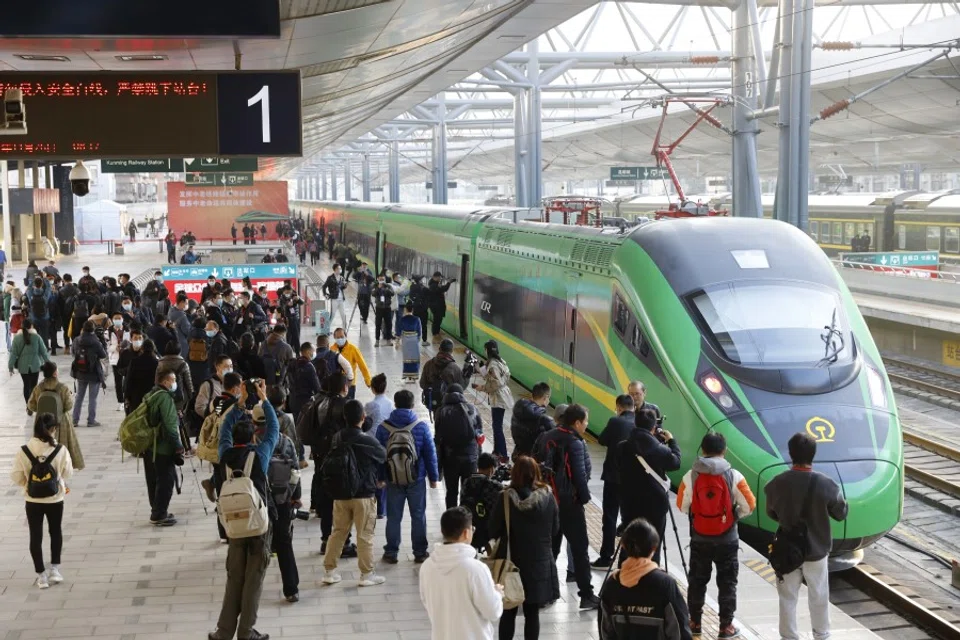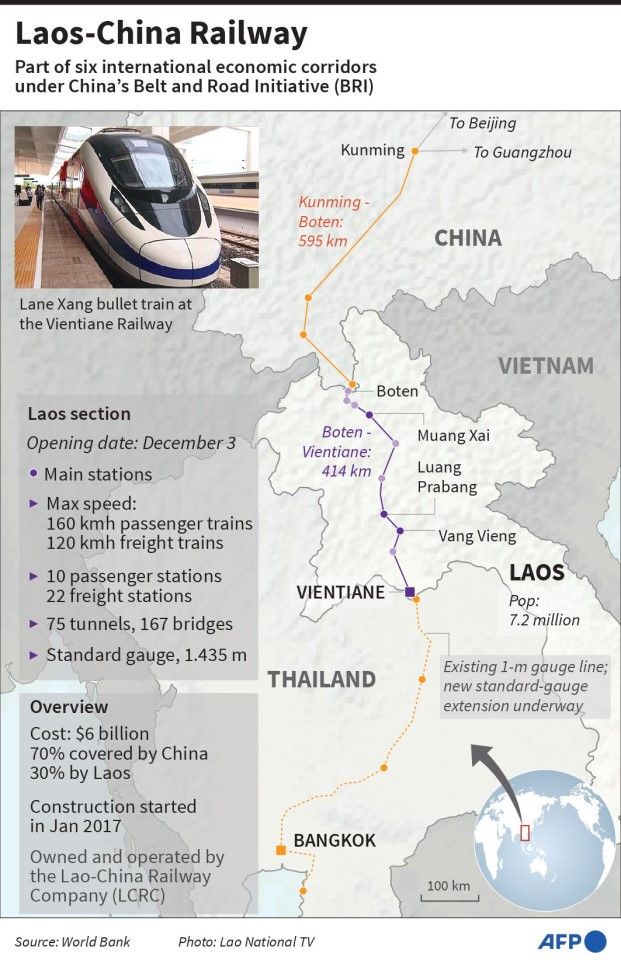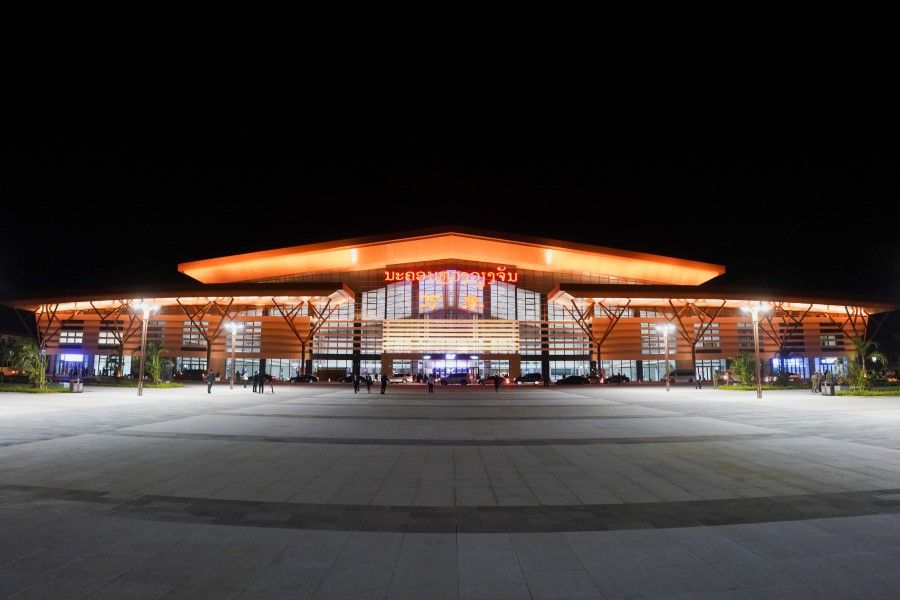Laos hopes for economic boost with the opening of Laos-China Railway

On 3 December 2021, the new railway line linking Kunming in China to Vientiane in Laos was formally opened. With the exception of the 3.5-kilometre-long railway line across the Mekong River linking the Thai border town of Nong Khai to the Lao border point at Thanaleng, opened in 2009, this marks the first standard-gauge railway line in the country.
The railway will be operated by a joint venture, the Laos-China Railway Co. Ltd., which is 70% owned by the China Railway Group conglomerate, and 30% by the Lao National Railway State Enterprise (LNRE), under the Ministry of Public Works and Transport.
Construction work on the Laos-China Railway commenced in 2016. The 430-kilometre line comprises almost 200 kilometres of tunnels and over 160 bridges; it has been a considerable undertaking. With express trains travelling in excess of 120 kilometres per hour, the time for passengers and freight to get from Vientiane to the Chinese border crossing at Boten will be reduced from 15 hours by road to under four hours by train. The World Bank estimates that the cost of transporting freight to China will decrease by 30% or more.

The Lao government's original decision to invest in the railway, and thereby to increase its external debt obligation with China in order to underwrite a large part of the cost, attracted some controversy. Can a railway estimated to have cost more than US$5.9bn, equivalent to a third of Laos' GDP, deliver an adequate return? Views on this issue have varied. But regardless of this debate, the completed line is now poised to open, and the railway has the potential - and the word "potential" needs to be stressed - to be a major "game changer" for the Lao economy. The "trick" lies in converting that potential into tangible reality.
When construction began on the railway, the global pandemic was more than three years away. Now, the first trains will probably commence running with cross-border passenger traffic remaining restricted. The official launch may thus be akin to a "soft opening". It was recently reported that the Lao prime minister envisages freight being the main form of traffic at first, until cross-border passenger traffic returns to some kind of normalcy.
...harnessing the full economic potential of the railway line is not a given, and will depend on the successful enactment of various changes genuinely linking the railway to the Lao economy at large.

But looking beyond the pandemic and the gradual lifting of travel restrictions in 2022, one can easily envisage both passengers and freight using the line. A dedicated "dry port" is being developed at Thanaleng, close to Vientiane, for freight traffic. Its facilities will include a bonded warehouse, a trans-shipment station, a container port and other logistical services. There will be ten main train stations along the line, including one at the UNESCO world heritage site of Luang Prabang. Tourists from China visiting Laos are expected to use the line, while Lao companies will be presented with an opportunity to transport their goods more easily, speedily and cheaply to China's huge market.
As any Lao exporter would affirm, the high cost of transporting goods out of the landlocked country has been a perennial burden, making it difficult to compete on price with producers in other countries. It is hoped that the longstanding dependence on a relatively small number of road transport companies able to get containers to and from Bangkok port, a group depicted by some as a cartel, will be punctured by the opening of the railway line.
However, the World Bank, the Asian Development Bank and others have cautioned that harnessing the full economic potential of the railway line is not a given, and will depend on the successful enactment of various changes genuinely linking the railway to the Lao economy at large. This is not just about having the right physical infrastructure in place to ensure that people and cargo can transit to and from chosen destinations. It is also about having the right "soft infrastructure" of laws and regulatory frameworks for railway traffic to proceed smoothly, without getting caught up in excessive red tape, or encountering the kinds of delays that deter people and companies away from using it.
Further, for the railway to be a commercial success, it will need to catalyse new cargo and passenger traffic, and not simply rely on existing road traffic shifting over to it. More passengers and freight volumes will be needed, and these should not depend excessively on transit flows - that is, freight (and passengers) going from Malaysia and Thailand to China and passing through Laos.

The railway in context
The development of the Laos-China Railway has obviously not occurred in splendid isolation. And the Lao economy has not been immune from the impact of the global pandemic. International tourism has been virtually non-existent for 18 months, and, at the time of writing, borders remain largely closed to passenger traffic, whether air, road or rail.
The World Bank estimates that GDP growth in 2020 was just 0.4%, and it is currently forecasting 2.2% growth for 2021. For its part, the Asian Development Bank put GDP growth in 2020 at -0.5% and is forecasting 2.3% growth in 2021. The IMF opted for -0.4% growth in 2020 and a forecast of 2.1% for 2021. Not only have domestic jobs been lost as a direct consequence of Covid-19, there has also been an influx of Lao citizens returning home after losing their jobs abroad.
In January 2021, the Lao People's Revolutionary Party (LPRP) held its five-yearly congress, at which then-Prime Minister Thongloun Sisoulith was elevated to the posts of general secretary of the party and president of the state. He is on public record as having said that Laos' debt situation has been inadequately addressed, and that the country's public finances have not been managed well. A new socio-economic development plan was also unveiled at the party congress, envisaging average annual GDP growth of 4%, and graduation away from less developed country (LDC) status is now anticipated in 2026.
The subsequent National Assembly meeting, held in March, and prior to a second Covid-19 surge in the country, elected Phankham Viphavanh as the new prime minister. Laos' leadership now faces the task of reviving the national economy in 2022.

In September 2021, the World Bank issued a new draft country economic memorandum (CEM) for Laos that advocates leveraging the country's strategic location to bring about a more inclusive and sustainable growth model. Laos' earlier emphasis on energy generation and mineral extraction to drive economic growth has, the World Bank argues, created relatively few jobs while causing both environmental and macro-economic difficulties that would suggest that such an economic growth model is unsustainable. Add construction and forestry-related activities to the country's sources of economic growth, and it becomes clear that the economy is not adequately diversified. And, while the rate of natural resource depletion has come down markedly since 2011, installed electricity capacity will continue to grow in the years ahead, as more hydropower projects come on line.
Despite this heavy emphasis on resources, government revenues from the resource sector account for less than 2% of Laos' GDP, notes the World Bank, citing data sourced to the Ministry of Finance. A notable reason for this anomaly appears to be the price at which electricity is sold, both domestically and to neighbouring countries - at average tariff rates that are below the state-owned power utility's own cost recovery levels. This in turn has served to increase the debt exposure of state-owned power company, Électricité du Laos (EdL), much of which is guaranteed by the government. Meanwhile, the country's foreign exchange reserves, as measured by months of "import cover", have remained below three months.
Foreign exchange earnings from inbound Chinese tourists to Laos, as well as increased export earnings from larger quantities of Lao goods being shipped to China's massive market, are perhaps the two most obvious scenarios for such diversification.
In such a context, it is understandable that hopes are being pinned on the Laos-China Railway to create a more diversified economy. Foreign exchange earnings from inbound Chinese tourists to Laos, as well as increased export earnings from larger quantities of Lao goods being shipped to China's massive market, are perhaps the two most obvious scenarios for such diversification.
However, even as the formal opening of the railway arrives, available information on what precisely the railway service will entail - frequency of trains, pricing for tickets and freight costs, and more - has been scarce. If Lao companies were genuinely expected to be prepared for the railway's opening, and to adjust their business plans in order to take advantage of this "game changer", then they have not had much information to go on.

Going crypto
In a surprise development, in September 2021 the Lao government announced that it would be piloting cryptocurrency mining and trading, becoming the first government in Southeast Asia to formally do so. Six companies were granted permission to participate in the trial exercise that is akin to a regulatory sandbox initiative.
One reason for the surprise was that only a month earlier, the Bank of the Lao People's Democratic Republic, the country's central bank, had issued a warning against the use of cryptocurrencies by Lao citizens. But, with some reports suggesting that cryptocurrency mining and trading - including as a means of payment - were already occurring illicitly in the country, this pilot scheme may be the government's attempt to get ahead of the issue and to instil some degree of control.
Under the pilot scheme, the six participating companies will be able to both mine and sell cryptocurrencies, although presumably not to citizens in Laos. They will pay a capped fee for the energy they use to do so. The initiative will be overseen by the Ministry of Technology and Communications, with inputs from the finance, planning and investment, energy and mines, and public security ministries, as well as EdL and the central bank. A key determinant of its success will be ensuring that organized crime gangs do not infiltrate the exercise, whether from China or elsewhere, given the need for vigilance around money laundering and other illicit ventures.
In May 2021, the Chinese government announced that it would be banning cryptocurrency mining and trading. Prior to this, China had been by far the world's biggest player in the crypto mining space, accounting for over 75% of all power used by computers in Bitcoin mining. That figure dropped to zero by August of this year. A vacuum on the supply side of the cryptocurrency market was thus created, and a number of Chinese players are likely to have been looking for alternative locations to host their activities. Since one of the main criteria for successful crypto mining is access to electricity, both to power and then to cool the banks of computers used, Laos is an attractive location for that activity.

Some media reports suggest that the Lao government anticipates earnings of around Kip29 trillion, or some US$190 million, from Bitcoin mining in 2022, although it is not clear how such a figure was arrived at, given the volatility of cryptocurrency prices. Also unclear is how precisely the government will derive income from the pilot project, other than presumably in the form of a corporate tax on the crypto miners.
Going one step further, in October 2021, it was reported that the Lao government had agreed to study the potential for a central bank digital currency (CBDC) in partnership with a Japanese fintech company - Soramitsu.
Some observers will raise legitimate concerns over the risks of embracing cryptocurrencies, particularly in countries where the ability to enact, and then enforce, appropriate regulations is limited by constraints on institutional capacity. There is clearly a need for Laos to tread carefully in this space, and to manage expectations around what can reasonably be achieved. That being said, the pace at which the Lao government has responded to a perceived opening in the market caused by China's withdrawal from the crypto mining business and its lateral thinking around harnessing its natural resource wealth reflect a degree of initiative and innovation that commentators often imply are lacking in Laos. As always, the main determinant of success will be the effectiveness of execution.
For the railway to be a full-blown economic success, new policy, legal and regulatory measures and other governmental interventions to reap its full potential, will be necessary.
A hopeful future
As a potent symbol of modernity, the sight of a high-speed electric train passing through Laos' mountainous north is an evocative one, not unlike other major infrastructural investment projects, such as the Nam Theun II Dam. It marks another step in Laos' economic development, and a departure from its less developed country status of the past. Not surprisingly, considerable national pride and emotion, as well as money, have been invested in the railway.
In this context, the railway might be seen as injecting new vitality into the Lao corporate sector, as it recovers from the impact of the pandemic. It represents a "shot in the arm", as it were, for the country's economy. Like corporate communities around the world, Lao businesses have suffered during the pandemic, and will need support to revive and prosper in the years ahead.

But another way to look at the railway might be as a "Deus ex machina" (from the Latin, literally meaning "God from the machine"): a plot device occasionally used in plays or novels whereby a dilemma faced by a key character is abruptly resolved by an external event. This is not only because the railway itself provides a physical means by which people and goods can be transported more cheaply and more speedily between Laos and China; it is also because the railway will ideally help catalyse a series of second-order developments necessary to make it a real success, and for it to generate the economic returns desired by the Lao government. For the railway to be a full-blown economic success, new policy, legal and regulatory measures and other governmental interventions to reap its full potential, will be necessary.
As policy advisors often note, enacting economic reform is rarely easy. It often comes up against entrenched groups or institutions that are resistant to change, is undercut by more immediate policy priorities, or simply hits the buffers imposed by lethargy. In such cases, an external prompt or dynamic - a "Deus ex machina" - is often required to create the impetus to move economic reforms forward, and ensure their enactment by the state agencies mandated to deliver on them. The train arriving at Platform One in Vientiane's new railway station may well serve that purpose.

The Lao government has committed considerable sums of money and political capital to make this railway happen. It now needs to secure a return on that investment, as measured by vigorous use of the train service, in both directions, comprising passengers and goods. It simply cannot afford to have the railway become an underutilised asset. As such, we can expect the Lao government to have adequate incentive to move forward with developing the hard and soft infrastructure necessary to make the railway a success.
While developing a set of skills around railway logistics may not sound quite as exciting as cryptocurrency mining, it does have a more predictable economic upside, and almost certainly entails fewer risks. Most importantly, it has a greater chance of helping meet the need for a more inclusive economic growth path for the country in the years ahead. As the Lao economy starts to come out of the pandemic-induced hiatus of 2020-21, and "Laos Inc." attempts to revive its fortunes, the new railway will hopefully prove to be a worthwhile asset.
This article was first published by ISEAS - Yusof Ishak Institute as ISEAS Perspective 2021/158 "The Kunming-Vientiane Railway: A Post-pandemic 'Deus ex machina' for the Lao Economy?" by Nick J. Freeman.
